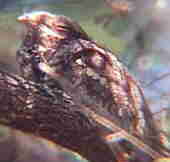 European
Nightjar European
NightjarCaprimulgus
europaeus
Description
The European nightjar is 10-11
inches long, and has a wingspan of about 24
inches
Its plumage of grays, browns
and russets makes it almost invisible when lying
on the ground, looking much like a piece of bark.
Males can be distinguished by their white spots
on the primaries and white tips to the outer tail
feathers. The bill is black, and the legs reddish
brown.
Distribution and
Habitat
This species of nightjar
summers in northern and central Europe (May to
October), and winters in sub-Saharan Africa as
far south as the Cape. It requires low, sparse
vegetation in which to nest, and lives in heathy
wastes, bracken-covered slopes, and open woods.
Diet
European nightjars will travel
a fair distance to preferred heathlands,
deciduous or mixed woodlands, orchards, riparian
and freshwater habitats, and gardens in order to
feed. The principal diet consists of flying
insects, which are usually caught on the wing.
Reproduction
Eggs are usually laid around
the of May. No nest is built, the two eggs,
creamy white mottled with brown, purple and
liver, being placed on bare ground amongst
bracken or stones. The male sometimes broods, but
most of the incubation and nest protection is
done by the female. If her eggs are threatened,
the female uses distraction displays to draw
intruders away. Chicks are covered with grey and
brown down. They quickly become active, and leave
the nest by mid-September.
Habits and Behaviors
Like most other nightjars, this
species is most active at dawn and dusk, spending
its day hidden away on the ground; it may not
move even if almost stepped on.
The males have a characteristic
churring song, similar to that of a cricket,
which can be heard on warm summer evenings. He
usually sings while lying or crouching along a
bough or rail, occasionally from a post or
branch.
Scientific
Classification
phylum Chordata
subphylum Vertebrata
class Aves
order Caprimulgiformes
family Caprimulgidae
genus & species Caprimulgus europaeus

ARKive http://www.arkive.org/nightjar/caprimulgus-europaeus/
Boreal Forests of the World www.borealforest.org/world/birds/european_nightjar.htm
Questions or comments about
this page?
|



